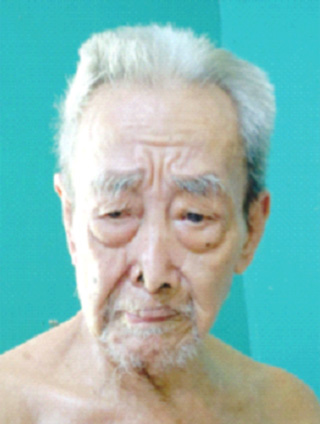Death March trail cutter found
Published on: Tuesday, August 23, 2016

Kota Kinabalu: A surprise 102-year-old surviving trail cutter of the original 1945 Death March route for the Japanese army, who was discovered early August, said he never cut the track to Kg Miruru.Despite his age, Tauty Akai had excellent hearing and a good memory of the events that took place more than 70 years ago and remains the best living witness to get the facts on where the death march route went. Talking to veteran trekker Tham Yau Kong, Tauty said a terse "tidak", meaning "no" in Malay, when asked whether the disputed mid section of the track between Bauto and Tampias ever reached Miruru.
ADVERTISEMENT
The centenarian's comments looks set to put to bed a dispute as to whether the death march route went through Miruru. Some 1,075 Australian and British soldiers died on the death march route cutting through jungle from Sandakan to Ranau by their Japanese captors and even more at the PoW camp in Sandakan during the closing stages of the seconde world war. There were three death marches in all and 2,345 others died in the PoW camp in Sandakan.Tauty said he was born in June 1914 and recruited by the Japanese Army to cut the death march track in early 1945 and for which he said he was paid loads of Japanese banana currency. If so, that Miruru was not part of the track looks set to settle a heated public dispute between Dr Kevin Smith and war historian Lynette Silver on where the mid section of the Death March passage went.
ADVERTISEMENT
Dr Smith claims that at Telupid, the track veered to the right towards Miruru via the Liwagu Valley but Lynette argues that it never went to Miruru, based on the hand-drawn map from the Australian Body Recovery team used by War Graves and later audited in 2012 by the Australian Army History and Mapping units. The feud went public when Lynette objected to a dotted alternative Miruru route that was added to a display route map endorsed by War Graves at the newly erected Ranau War Memorial museum in the SIB Church compound and took her objection privately to both the Director of Sabah Museum and the Minister of Culture, Tourism and Environment, Datuk Seri Panglima Masidi Manjun.
ADVERTISEMENT
In a surprise turn of events, Dr Smith wrote a lengthy article to the Daily Express defending his Miruru-bound alternative death march route and Lynette responded with her own, arguing that Miruru never happened and urged the alternative route be struck out on account that it was not a historical fact. While Lynette retreated to further study and published in her website a 27-page report on her position, Tham accidentally stumbled upon Tauty Akai, who now appears the one and only living Death March trail cutter."It happened in early August, when I was leading the 14-strong Royal British Engineers on a 271km complete head to foot Sandakan-Ranau trek of the death march track."Just 10km from Bauto, we passed by the house of Midor Tauty who was the Headman of Kg Buis. As the custom is, every village that we go in Sabah, it is a matter of respect to call on the village chief," Tham said. "While talking to him, Midor dropped a bombshell saying: 'My father (Tauty Akai) knows a lot about the Death March because he was one of the original trail cutters!'. "That extraordinary claim got me very excited and I told him I wanted to meet his father and Midor agreed to arrange a meeting which eventually took place on Aug. 14 at Kg Sg Tontinting where Tauty now lives with Midor," Tham related the sequence of events. Tham said because of the ongoing dispute between Dr Smith and Lynette, he posed specific questions to Tauty in an interview last week to find out from the horse's mouth. Following is the interview : Tham: Apa kamu buat musim Jipun? (What did you do during Japanese time?)Tauty: Jipun panggil potong rentis untuk orang putih (The Japanese told us to cut a track for the white men).Tham: Kau potong rentis ada sampai Miruru? (Did the track you cut reach Miruru?)Tauty : Tidak (No).Tham: Mana jalan (Where did the track go ?)Tauty: Bauto limpas banyak sungei – sg Telupid, sg Tapang , sg Koporon sampai Lipang (sg Kakibangan), Tampias (From Bauto, it crossed many rivers (streams) like Sg Telupid, Sg Tapang, sg Koporon etc until Lipang (sg Kakaibangan) in Tampias. Tham said Tauty conceded that he was paid loads of Japanese dollars for the job. So now, the historical evidence on exactly where the mid section went looks conclusive, given a direct testimony from an original member of crew that cut the Death March track alongside Pangima Kulang (Beluran) and Panglima Akui (Paginatan), that the track did not reach Miruru. Besides his trail cutting and maintenance job, Tauty also claimed that while cooking rice one evening, he saw a group of sick and emaciated white men pass by –likely part of the original 536 2nd batch of Death March which departed Sandakan on 29 May and driven through the jungles, after an intense Allied bombing raid which convinced Japanese and prisoners alike that an invasion was imminent.But being in the employ of the Japanese Army, he was unable to offer rice to the hungry-looking PoWs, a miss which still bothers his conscience until now, he says. Tauty said he noticed that the prisoners had tied strips of cloth around their blister-filled feet in an attempt to soothe pain or protect themselves from thorns or stones.Stay up-to-date by following Daily Express’s Telegram channel.
Daily Express Malaysia




